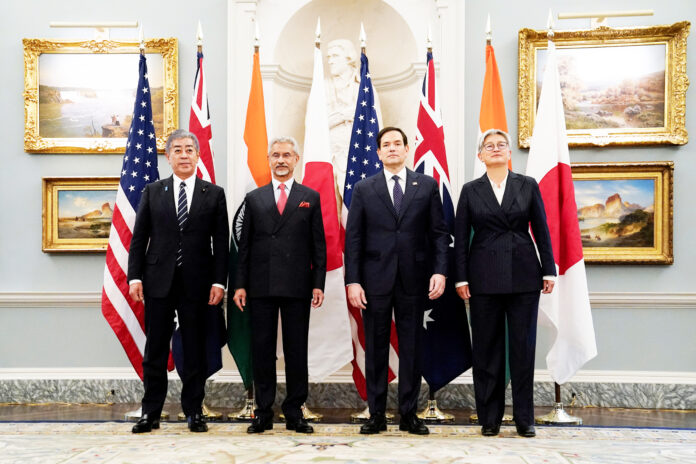
The Quad meeting holds added importance at a time when the US, embroiled in the Russia-Ukraine war and more directly in the Iran-Israel war, is seen to be losing its strategic focus to counteract China’s assertive rise in the Indo-Pacific region.
Multilateral and minilateral groupings of all hues and designs are in their most heightened phase of transition and transformation recalibrating and readjusting to the seismic shifts in global affairs. The Quadrilateral Security Dialogue (Quad) stands at a critical phase of churning in the Indo-Pacific region, where America’s commitments are being questioned and China is trying to woo its neighbours by offering economic incentives.
Even as the Trump team negotiates a new trade arrangement with China, the Quad foreign ministers met in Washington D.C. and called out China’s coercive activities in the South and East China Seas, and established new understandings on critical minerals, to counteract China’s domination over minerals resources that are inevitable for future defence and commercial technologies. India’s Foreign Minister S. Jaishankar met his counterparts, and released a joint statement, preparing grounds for the upcoming Quad Leaders’ Summit to be hosted by India later this year.
The Quad meeting holds added importance at a time when the US, embroiled in the Russia-Ukraine war and more directly in the Iran-Israel war, is seen to be losing its strategic focus to counteract China’s assertive rise in the Indo-Pacific region. Successive US presidencies, Republican and Democrat, have identified the Indo-Pacific region as the region of priority in the US strategic calculus, but US global commitments and its domestic politics often remind Washington of the trials and tribulations of being a global power.
At least since the end of World War II, the United States has shown both the capability and the intention to shape the international system in its own favour. But history is witness to the fact that not even a global power like the US is completely successful in maintaining its writ over global affairs and geopolitics that are beyond its own control and sometimes of its making. The United States is passing through a phase of profound uncertainties in the extent to which it can wield its power to influence global and regional outcomes. While it remains unchallenged in its comprehensive national power, the ability of countries, both friends and foes to shape the international system has been growing, resulting in a more diffused distribution of power in the world order.
Trump’s second term has substantially impacted America’s engagement with the rest of the world, across the spectrum. From his tariff policies to his approach towards climate change and energy transition, and to how the US is going to engage with allies and partners, there has been a constant churning. From the Shangri-La Dialogue to the North Atlantic Treaty Organization (NATO) summit, Trump’s defence team has been pushing allies and partners to increase their share of maintaining the regional security apparatuses and to stop free riding on US security commitments. In their recently concluded summit, NATO countries by and large agreed to increase their defence spending to 5% in the next one decade, by 2035.
The Trump administration seems to believe that with the Europeans picking up slack and doing more to deter Russian aggression in the European security environment, the US will and can devote more resources to counteracting China’s coercive activities in the Indo-Pacific region, in the pursuit of establishing a “free, open and inclusive” Indo-Pacific. China has risen as a global power in multiple parameters, and challenges the US in almost all fronts of the great power competition, including the economy, military and more particularly in the race for new technologies. China’s dominance over critical and rare earth minerals that will fuel the next generation of defence and commercial technologies has become a matter of concern not only for the US but also like-minded partners that are looking to de-risk any undue dependence on China’s resources and prevent it from controlling the supply chains.
Therefore, the Quad Critical Minerals Initiative, aimed at securing and diversifying critical minerals supply chains is noteworthy. But the proof of the pudding is in the eating. The India-US technology partnership as well the Quad is filled with promises but it has to be seen how they create synergy and amplify the joint vision in such areas, while not decoupling entirely from the Chinese ecosystem. Moreover, infusing greater interoperability in logistics lie at the very heart of the joint visions and strategic plans for freedom of navigation and unhindered commerce across the seas of the Indo-Pacific waters.
As the Quad countries and other like-minded partners work towards multi-modal connectivity projects and infrastructure building across regions, making sure that geopolitical convulsions like the ones currently experienced in West Asia do not impede commercial routes that are crucial for unimpeded growth and development becomes germane. In this pursuit, the 1st Quad Indo-Pacific logistics network field training exercise will be significant towards capability and capacity building. Moreover, the Foreign Ministers’ meeting also underscored the plan to launch the Quad Ports of the Future Partnership in Mumbai this year. The maritime space is pregnant with extensive commercial opportunities but are also plagued with tremendous risks that are born out of inter-state power dynamics and non-traditional security threats.
Given India’s long and diverse coastline, and its central role in India’s vision of becoming a developed country by 1947, stronger coast guard cooperation, maritime legal dialogues and regional training initiatives are instrumental at confidence building and sustaining cooperative mechanisms among concerned agencies and institutions. Quad emerged as an informal and temporary group of first responders to the devastating Indian Ocean tsunami of 2004, and how this group continues to keep humanitarian assistance and emergency response as a priority area of joint strategy and operations will be crucial to a people-centric Quad.
Moreover, how groupings like the Quad that cater to a long list of humanitarian oriented maritime cooperation across the Indo-Pacific aligns with India’s newly envisioned Mahasagar Initiative, will also be germane to the integration of national and minilateral strategies. Any misalignment in priorities of the member countries will be vulnerable to the interfering operations of countries whose ambitions run counter to a rules-based regional order.
Monish Tourangbam is a Senior Research Consultant at the Chintan Research Foundation, New Delhi.






